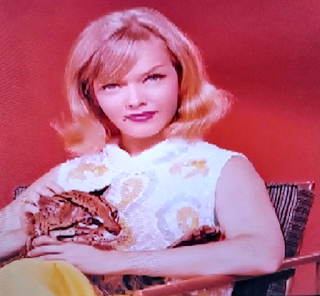Opening Theme and Images of "Honey West"
Previous: Introduction Next: Episode 1: The Swingin' Mrs. Jones
The musical opening of "Honey West" combines jazzy music and striking images that pack a lot into about thirty seconds.
Joseph Mullendore (credited here simply as Mullendore) had composed some music for "Burke's Law," the series that introduced Honey West and Sam Bolt in April 1965. Mullendore composed a lot of music for movies and TV, usually only within episodes, although he wrote the theme music for some older TV series and movies. He worked primarily as an orchestrator-arranger. He was born in Philadelphia in 1914 and died in Pasadena, California in 1990 at age 75.
The “Honey West” musical theme is jazzy and brassy. It begins with a show-bizzy fanfare, becomes blaring, dire and jagged, and ends on a bouncy flourish. If I were to criticize it, I would say it seems to be all over the place. Much of the theme sounds like other TV theme music of the era. The way it ends, on that bouncy note, could have ended the theme of a sitcom rather than a crime series.
The really amazing thing about the musical opening is the imagery. A lot of it—especially during the jagged middle part—feels apropos to a crime drama, especially one about an empowered female hero who is ultimately triumphant without losing her femininity. (I'll bet you didn't know all of that is contained in the opening.)
Initially, the image is laughably on the nose: There is a honeycomb ("Honey," get it?), and Anne Francis progressively appears in each and every cell of the honeycomb.
Then we get a closeup of those unmistakable lips with the trademark mole below the right corner. (Honey West’s creator, Skip Fickling, actually gave her a mole, but, in the novels, it was above her lips rather than below them. BTW rumor has it that Anne Francis’s mole was not real; actually, it was, and her biological daughter also has one.)
Then we see closeups of Honey in dark glasses (the mole still visible); then whispering in an ear (mole not visible);
then a closeup of lips closing in for a kiss, so close that they are about to shut out the light behind them, and this, like many of the images in the opening, lasts for a tiny fraction of a second.
There follows a well-coordinated sequence, backed by horns blaring in sharp peaks, and these images tell a disjointed but identifiable story:
A man’s face is reflected in an extreme closeup of the lens of a woman’s sunglasses (presumably Honey's);
a hand, bent like a claw, reaches; Honey’s mouth opens as if to scream; a hand covers her mouth, her eyes show alarm;
a man’s eyes are seen in extreme closeup; then Honey looks determined;
Honey with her arms raised (either as if she has broken the hold of the man before her, or is pretending to hold her arms up in surrender to someone who might be holding an unseen gun);
Honey puts a man in a choke hold from behind, pushing him down. A look of terror in HIS eyes;
a woman’s hand stiffened and ready to deliver a karate chop.
Then, Honey delivers a chop to a man’s neck;
and the man on his back.
What can be seen of his body is disorientingly on the diagonal, with his head approaching the lower right of the image. The fingers of his left hand curl uselessly. A pistol lies near his head, but though he might be looking toward it, he does not reach for it.
Subliminally, this sequence teaches us—if we really can learn anything from split-second images—that this series is about a woman who triumphs over intimidation, chaos, and her own fears. The show does let her fall back on feminine weakness at times because the writers could not escape being influenced by the traditional roles of women. But often, Honey uses men's expectations of her weakness to her advantage, lulling them into complacence and then into compliance.
A few of the images in this opening do not make sense: for example, a building of at least six stories—perhaps a factory, as there are no curtains in the squarish windows—taken with a lens that seems to have droplets of light-reflecting water(?) on it.
This is followed by an image of Honey and Sam with his arm around her shoulders.
Another closeup of a man, this one with a hat (perhaps a subject of surveillance?), and then a shot of Sam operating a long-range, directional microphone, known as a "shotgun."
This image is actually from the "Burke's Law" episode "Who Killed the Jackpot?" (See also the film, “The Conversation,” about a private eye who becomes uncomfortable about the ethics of listening in on people.)
There are pictures of Honey in a femme blouse but with a handgun;
and a kaleidoscopic picture of the same open-mouthed (screaming?) man rendered in half a dozen overlapping iterations.
The face of an ocelot morphs, step by step, into that of Honey.
But as the music glides into a jaunty melody, we see a more feminine side to Honey, wearing an evening gown.
Over this glam shot, we learn the pecking order on the show: “Starring Anne Francis”; and this is followed by a shot of Sam with the legend “Co-starring John Ericson.”
And finally a two shot of the co-stars together:
(Surprise! Irene Hervey as Aunt Meg is not credited at the beginning of each episode, but at the end of each episode—if she is in it. At the end, Anne and John are credited—a second time for each of them—and only then is Hervey given her credit.)
Opening Theme and Images (You are already here)
Episode One: The Swingin' Mrs. Jones


























Comments
Post a Comment